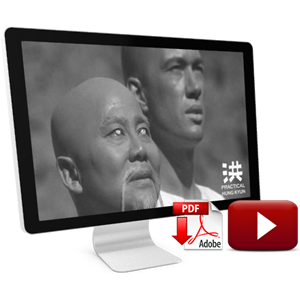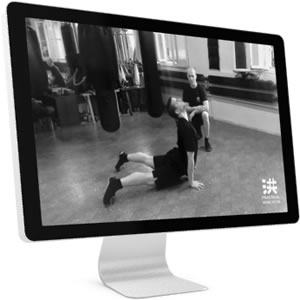 Grandmaster Lam Cho 林祖, patriarch of Lam Family Hung Kyun 林家洪拳, also known as Lam Gun Kau 林冠球, was born on the 1st month, 18th day, of the Chinese calendar year 4608 (February 27th, 1910), in the Southern Chinese province of Gwongdung 廣東, Naamhoi 南海 district, Ping Jau 平洲 village. Orphaned as a young child, he was brought up by his uncle, the famous martial arts master Lam Sai Wing 林世榮, a disciple of the legendary Wong Fei Hung 黃飛鴻. Lam Sai Wing treated the young Lam Cho as his very own son.
Grandmaster Lam Cho 林祖, patriarch of Lam Family Hung Kyun 林家洪拳, also known as Lam Gun Kau 林冠球, was born on the 1st month, 18th day, of the Chinese calendar year 4608 (February 27th, 1910), in the Southern Chinese province of Gwongdung 廣東, Naamhoi 南海 district, Ping Jau 平洲 village. Orphaned as a young child, he was brought up by his uncle, the famous martial arts master Lam Sai Wing 林世榮, a disciple of the legendary Wong Fei Hung 黃飛鴻. Lam Sai Wing treated the young Lam Cho as his very own son.
Lam Sai Wing’s Nephew and Adopted Son
When the Ching Dynasty ended in 1911, Lam Sai Wing brought Lam Cho with him to Hong Kong, as he was invited by the Hong Kong Butcher’s Association 香港肉行公會 to teach martial arts there. Lam Cho started his training in the Chinese martial arts at age of 6. Along with gungfu, he also studied the traditional art of herbal healing and bone-setting 跌打醫科. By the age of 16 he began to teach, at first, as an instructor in Lam Sai Wings’ main school, the “Lam Sai Wing Martial Arts Association” 林世榮國術團, as well as in the “Southern Martial Arts Athletic Association” 南武體育會, then later, as chief instructor for the “Lam Sai Wing Martial Arts Association, First Branch” 林世榮國術團第一支部, with his Gung Fu training brother Dang Hin Choi 鄧衍才 managing the newly opened “Lam Sai Wing Martial Arts Association, Second Branch” 林世榮國術團第二支部. Owing to Lam Cho’s power, speed, dexterity and perfection of technique, he soon became quite famous, and people called him “Sifu” 師傅 as a young man.

In 1933 Lam Cho took over the teaching at the “Second Branch” as well. He then became Lam Sai Wing’s official successor, re-naming the organization to, “Lam Cho’s Martial Arts Association” 林祖國術社. One of his classmates, Leung Wing Hang 梁永亨, designed a logo for the new association, the now-famous “Tiger and Crane” insignia 虎鶴章, replacing the original circular logo of Lam Sai Wing (with the inscription “Lam’s Training Hall” 林館 written inside of it). Thus, the “Tiger and Crane” insignia, with its characteristic diamond shape, became the trademark of his lineage, and Lam Family Hung Kyun, also called “Tiger and Crane Hung Kyun” 虎鶴洪拳 spread over the whole of Southern China.
Anti – Japanese Resistance and Post World War Teaching
During the Second World War, Lam Cho actively joined the anti-Japanese resistance. After the Japanese invasion of Hong Kong, disturbances broke out in the streets, and Lam Cho`s school was closed down. The Japanese recognized that Lam Cho was a man with considerable influence over the local townspeople, and tried to force him to become a member of the local administration. Lam Cho refused to co-operate with them. He escaped to his native land in Gwongdung, and continued to teach martial arts there for the Pun Yu 番禺 district government, at San Jou Village 新造鄉.
After the war, he moved back to Hong Kong, and re-opened his school and medical practice at Stone Nullah Lane in Wan Chai, and acted as a martial arts consultant for many associations and companies, such as the “Hong Kong/Kowloon Oven-Fired Confectionery Worker’s Union” 港九燒菓爐工會, the “Kowloon Citizen’s Gymnasium”, 九龍公民健身會, the “Hong Kong/Kowloon Restaurant and Tea-House Worker’s Union 港九酒樓茶室工會, and the “Hong Kong/Kowloon Paper Box Packaging Worker’s Union 港九裝璜紙盒業職工會. In 1963, The Wan Chai school was taken over by his son, Lam Chun Hin 林鎮顯, when Lam Cho moved again to Kowloon side, to Nullah Road, Mong Kok.

Lam Family
Grandmaster Lam Cho’s beloved wife and mother of his children, Tam Yeut Ming譚月明, has already passed away in 1979. Of Grandmaster`s sons, the eldest, Anthony Lam Chun Fai 林鎮輝, the second-youngest, Simon Lam Chun Chung 林鎮忠 and the youngest, Lam Chun Sing 林鎮成 continue to spread the art of Hung Kyun. Grandmaster’s second-eldest son, the talented Lam Chun Hin 林鎮顯, unfortunately passed away in the 1980′s. His wife, Luk Lai Yin 陸麗燕 , yet maintains the “Lam Chun Hin Dit Da Clinic” 林鎮顯醫館 at the “Blue House”, on Stone Nullah Lane, Wanchai. Grandmaster raised two daughters as well, the eldest, Lam Fung Chan 林鳳珍, and the youngest, Lam Fung Chu 林鳳珠. Both sisters were well-known performers in their father’s martial art demonstrations for many, many years.
Grandmaster’s adopted son, Tang Kwok Wah 鄧國華, passed away in 2011, after having lived and taught Hung Kyun in the United States since the 1960’s. Many of Grandmaster’s students and grand-students have spread the art of Hung Kyun overseas. Also residing in the U.S.A., Lei Yatming 李一鳴, Y.C. Wong 黃耀楨, Kwong Tit Fu 鄺鐵夫, and Bucksam Kong 江北山, have been the best-known propagators of Lam family Hung Kyun in the western world.

Chinese Martial Arts and Longevity
Grandmaster Lam Cho officially retired in the 1970’s, yet he continued to practice his martial arts, most notably the “Iron Thread Set” (Tit Sin Kyun 鐵線拳), renowned for its rejuvenating properties. All through the 1980’s it was not uncommon for Grandmaster to invite his students, and even personal friends, to come join him for an early-morning session of “Iron Thread” training. Grandmaster credited this practice with having kept him healthy, active, and strong until attaining more than one hundred years of age!
Grandmaster did not believe in the old custom of Baai Si 拜師, or of indoor students 入室弟子. He felt that once a student had joined his school, it should be enough. Although Grandmaster did not accept new students in his retirement, those students who had already learned from him, their students, and even grand-students, were always welcome to come to visit him and to practice, as it was his pleasure to continue teaching at his leisure. Taking great satisfaction in such visits, he would often state, “as long as I am yet alive, my doors are open, that students around the world may know my standard”, and also urged that “collaboration among Hung Kyun practitioners is of prime importance to the future of our Hung Kyun martial arts”.
Grandmaster Lam Cho likewise continued accept and treat Dit Da patients on a regular basis, together with his youngest daughter, Lam Fung Chu 林鳳珠, who has inherited all of her father’s Dit Da healing skills. Today, she yet maintains the “Lam Cho Dit Da Clinic” 林祖跌打醫館, located on Nullah Road, Kowloon.
Grandmaster ’s Legacy
 Recognized for many years as “the last surviving student of Lam Sai Wing”, and for being one of the foremost authorities in modern Hung Kyun, Grandmaster Lam Cho was also quite innovative during his lifetime, improving the system in many ways, such as adapting principles and techniques of various other southern, and even northern styles (thanks to his sworn brotherhood with Gang Dak Hoi 耿德海, founder of the Daai Sing Pek Gwa Mun 大聖劈掛門 system), adding weapon sets, developing sparring sets, and other methods for training skills which comprise the curriculum of Lam Family Hung Kyun today.
Recognized for many years as “the last surviving student of Lam Sai Wing”, and for being one of the foremost authorities in modern Hung Kyun, Grandmaster Lam Cho was also quite innovative during his lifetime, improving the system in many ways, such as adapting principles and techniques of various other southern, and even northern styles (thanks to his sworn brotherhood with Gang Dak Hoi 耿德海, founder of the Daai Sing Pek Gwa Mun 大聖劈掛門 system), adding weapon sets, developing sparring sets, and other methods for training skills which comprise the curriculum of Lam Family Hung Kyun today.
Although Grandmaster Lam Cho has passed away, his spirit lives on, through his work, through his family, and through his students worldwide. Our deepest condolences to his family, and our heartfelt appreciation for all that he has done.
About the Authors: Gung Fu brothers Michael Goodwin Sifu (www.sfhunggar.com) and Pavel Macek Sifu (www.practicalhungkyun.com) are disciples of Grandmaster Lam Chun Sing. The above article was written for KungFuMagazine.com (Hung Kyun Grandmaster Lam Cho Has Passed Away at 103) in 2012. It is now republished exclusively at our website with all original Chinese characters.
If you like the article and if you want to support our work, please add your comment, click “tweet” or “like”. Your support will help us and encourage us to publish and share more articles and videos in the future!
Thank you for every visit, “tweet”, “like” or comment!
Upcoming Events!
[events_list]
-

Chinese Martial Arts: The Secrets of the Old Grandmasters
$9,95 Add to cart -
Sale!

PHK Intro Kit: Beginner’s Guide to Chinese Martial Arts
Original price was: $149,00.$79,00Current price is: $79,00. Add to cart -

Chan Hon Chung Sifu – “Moon Shadow Hand & Kick Poster
$9,95 Add to cart -

Chan Hon Chung’s Tiger and Crane Double Form Set Manual
$19,95 Add to cart
![]()

